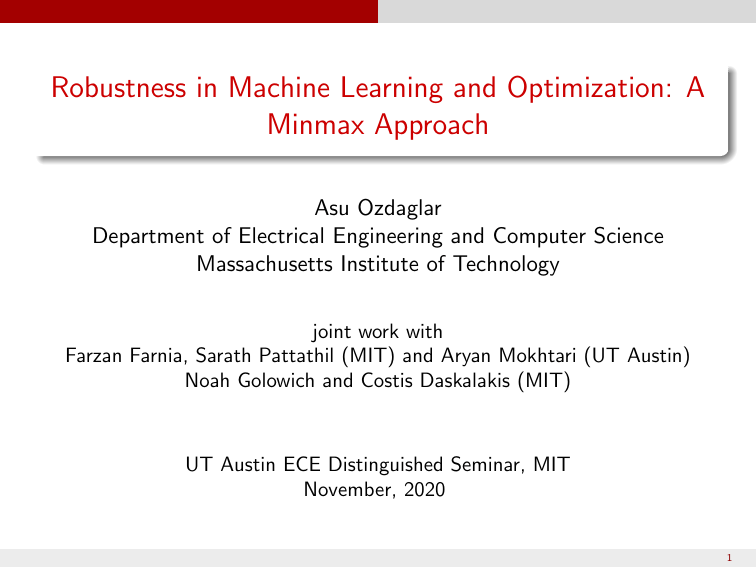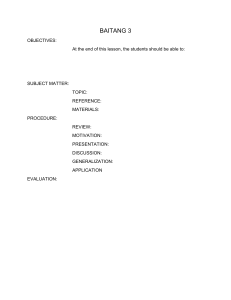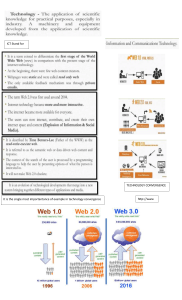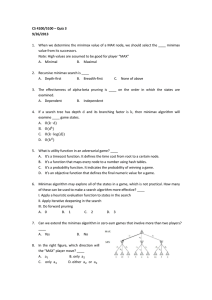
Robustness in Machine Learning and Optimization: A
Minmax Approach
Asu Ozdaglar
Department of Electrical Engineering and Computer Science
Massachusetts Institute of Technology
joint work with
Farzan Farnia, Sarath Pattathil (MIT) and Aryan Mokhtari (UT Austin)
Noah Golowich and Costis Daskalakis (MIT)
UT Austin ECE Distinguished Seminar, MIT
November, 2020
1
Minmax Problems
We are interested in the following minmax problem:
min max f (x, y)
x∈Rm y∈Rn
These arise in a multitude of applications:
Worst-case design (robust optimization): We view y as a parameter and
minimize over x a cost function, assuming the worst possible value of y.
Duality theory for constrained optimization:
Primal problem:
minm f (x)
s.t. gj (x) ≤ 0,
x∈R
j = 1, · · · , n
Given a vector µ = (µ1 , · · · , µn ), Lagrangian
function is given by:
n
X
L(x, µ) = f (x) +
µj gj (x)
j=1
The dual problem is given by:
max minm L(x, µ)
µ≥0 x∈R
Thus the dual problem is a minmax problem.
2
Computing Saddle points
We are interested in finding saddle points of the function f , i.e., points
(x∗ , y∗ ) ∈ Rm × Rn which satisfy:
f (x∗ , y) ≤ f (x∗ , y∗ ) ≤ f (x, y∗ ) for all x ∈ Rm , y ∈ Rn .
Standard method for computing saddle points: Gradient Descent Ascent
(here η ≥ 0 is a fixed stepsize)
xk+1 = xk − η∇x f (xk , yk ),
yk+1
= yk + η∇y f (xk , yk ).
Some history:
[Arrow, Hurwicz, Uzawa 58] proposed CT versions of these methods
for convex-concave functions and proved global stability results
under strict convexity assumptions.
[Uzawa 58] focused on a DT version and showed convergence to a
neighborhood under strong convexity assumptions.
[Gol’shtein 74] and [Maistroskii 77] provided convergence with
diminishing stepsize rules under stability assumptions (weaker than
strong convexity).
3
Earlier Literature
Much of the focus on strong convexity-concavity type assumptions.
4
Relaxing Strong Convexity
We considered a subgradient algorithm for generating approximate saddle
point solutions for convex-concave functions based on the seminal
Arrow-Hurwicz-Uzawa algorithm and the averaging scheme (see [Bruck 77],
[Nemirovski, Yudin 78])
x̂N =
N
1 X
xi ,
N
i=1
ŷN =
N
1 X
yi
N
i=1
Theorem (Nedic and Ozdaglar, 09’)
Assume that the (sub)gradients of f are uniformly bounded by L. Then, the
iterates generated by GDA with stepsize η ≥ 0 satisfy
1
|f (x̂N , ŷN ) − f (x∗ , y∗ )| ≤ O
+ O(ηL2 )
ηN
Boundedness assumption may be restrictive (works for compact domains).
5
Minmax Problems in Machine Learning
Adversarial robustness through minmax optimization
Standard training: Selecting model parameters x to minimize expected
loss E(w ,θ)∼P [`(w , θ, x)].
Robust training: Consider inputs with adversarial modifications
represented as `∞ -perturbations y of data points w ([Madry et al., 17’])
The robust learning problem then amounts to choosing x to solve the
following minimax problem:
h
i
min E(w ,θ)∼P max `(w + y , θ, x) ,
x
y ∈S
where S denotes allowable perturbations.
6
Minmax Problems in Machine Learning
Generative Adversarial Networks (GANs)
Goal: Learn the distribution of observed samples x1 , . . . , xn
Formulated as a zero-sum game with two players (neural networks):
Generator G generating real-like samples from random input z.
Discriminator D distinguishing generated samples from real samples.
Leads to a minmax optimization problem [Goodfellow et al. 14]:
min max
G
D
n
n
1X
1X
log D( xi ) +
log 1 − D(G (zi ))
n i=1
n i=1
Nonconvex-nonconcave minmax problem since both the generator and
discriminator are neural nets.
7
Challenges in Training GANs
GAN training (where the generator and discriminator are trained using
first order methods) commonly suffers from:
Instability
8
Challenges in Training GANs
GAN training (where the generator and discriminator are trained using
first order methods) commonly suffers from:
Instability
Mode Collapse
8
Convergence of GDA
Even for the simple bilinear case, GDA diverges.
Consider the following bilinear problem:
min max f (x, y) = x> y
x∈Rd y∈Rd
The solution is (x∗ , y∗ ) = (0, 0).
The Gradient Descent Ascent (GDA) updates for this problem:
xk+1 = xk − η yk ,
|{z}
∇x f (xk ,yk )
yk+1 = yk + η xk
|{z}
∇y f (xk ,yk )
where η is the stepsize.
9
GDA
After k iterations of GDA algorithm, we have:
kxk+1 k2 + kyk+1 k2 = (1 + η 2 )(kxk k2 + kyk k2 )
GDA diverges as (1 + η 2 ) > 1
10
OGDA
The simple GDA algorithm does not work even for bilinear problems:
xk+1 = xk − η∇x f (xk , yk ),
yk+1 = yk + η∇y f (xk , yk ).
Recent popular variant: Optimistic Gradient Descent Ascent (OGDA)
(GDA with negative momentum)
xk+1 = xk − 2η∇x f (xk , yk ) +η∇x f (xk−1 , yk−1 )
yk+1 = yk + 2η∇y f (xk , yk ) −η∇y f (xk−1 , yk−1 )
Introduced in [Popov 80].
Studied in [Rakhlin et al. 13] in the context of Online Learning.
Convergence to a neighborhood for bilinear case [Daskalakis et al.18].
Exact convergence for bilinear case and strongly convex-strongly concave case
[Liang and Stokes 19], [Gidel et al. 19], [Mokhtari et al. 19].
11
OGDA
OGDA updates for the bilinear problem
xk+1 = xk − η(
2yk − yk−1
| {z }
)
2xk − xk−1
| {z }
)
2∇x f (xk ,yk )−∇x f (xk−1 ,yk−1 )
yk+1 = yk + η(
2∇y f (xk ,yk )−∇y f (xk−1 ,yk−1 )
12
Proximal Point
The Proximal Point (PP) updates for the same problem:
xk+1 = xk − η
yk+1
|{z}
yk+1 = yk + η
∇x f (xk+1 ,yk+1 )
xk+1
|{z}
∇y f (xk+1 ,yk+1 )
where η is the stepsize.
The difference from GDA is that the gradient at the iterate (xk+1 , yk+1 )
is used for the update instead of the gradient at (xk , yk ).
Although for this problem it takes a simple form
xk+1 =
1
(xk − ηyk ) ,
1 + η2
yk+1 =
1
(yk + ηxk )
1 + η2
Proximal Point method in general involves operator inversion and is not
easy to implement.
13
Proximal Point
On running PP, after k iterations we have:
1
kxk+1 k2 + kyk+1 k2 =
(kxk k2 + kyk k2 )
1 + η2
PP converges as 1/(1 + η 2 ) < 1
14
OGDA vs Proximal Point
It seems like OGDA approximates Proximal Point method!
Their convergence paths are very similar
15
Outline
We view OGDA as an approximation of PP for finding a saddle point.
We use the PP approximation viewpoint to show that for OGDA
The iterates remain bounded.
Function value converges at a rate of O(1/N).
We revisit the Extra Gradient (EG) method using the same approach
We then focus on the last iterate convergence of the EG algorithm.
We show it is provably inferior to the ergodic iterate in the
convex-concave setting.
We finally turn to analysis of generalization properties of gradient based
minmax algorithms using algorithmic stability framework defined by
[Bousquet and Elisseeff 02].
16
Problem
We consider finding the saddle point of the problem:
min max f (x, y)
x∈Rm y∈Rn
f is convex in x and concave in y.
f (x, y) is continuously differentiable in x and y.
∇x f and ∇y f are Lipschitz in x and y. L denotes the Lipschitz constant.
(x∗ , y∗ ) ∈ Rm × Rn is a saddle point if it satisfies:
f (x∗ , y) ≤ f (x∗ , y∗ ) ≤ f (x, y∗ ),
for all x ∈ Rm , y ∈ Rn . Let f ∗ = f (x∗ , y∗ ).
17
Proximal Point
The PP method at each step solves the following:
1
1
(xk+1 , yk+1 ) = arg minm maxn f (x, y) + kx − xk k2 − ky − yk k2 .
x∈R y∈R
2η
2η
Using the first order optimality conditions leads to the following update:
xk+1 = xk − η∇x f (xk+1 , yk+1 ),
yk+1 = yk + η∇y f (xk+1 , yk+1 ).
Theorem (Convergence of Proximal Point )
The iterates generated by the PP method satisfy
h
max
y:(x̂N ,y)∈D
i h
f (x̂N , y) − f ? + f ? −
i
D
.
f (x, ŷN ) ≤
ηN
x:(x,ŷN )∈D
min
D = kx0 − x∗ k2 + ky0 − y∗ k2 , D := {(x, y) | kx − x∗ k2 + ky − y∗ k2 ≤ D}.
18
OGDA updates - How prediction takes place
One way of approximating the Proximal Point update is as follows
∇x f (xk+1 , yk+1 )) ≈ ∇x f (xk , yk ) + (∇x f (xk , yk ) − ∇x f (xk−1 , yk−1 ))
∇y f (xk+1 , yk+1 )) ≈ ∇y f (xk , yk ) + (∇y f (xk , yk ) − ∇y f (xk−1 , yk−1 ))
This leads to the OGDA update
xk+1 = xk − η∇x f (xk , yk ) − η(∇x f (xk , yk ) − ∇x f (xk−1 , yk−1 ))
yk+1 = yk + η∇y f (xk , yk ) + η(∇y f (xk , yk ) − ∇y f (xk−1 , yk−1 ))
19
Convergence rates
Theorem (Convex-Concave case)
Let the stepsize η satisfy 0 < η ≤ 1/2L. Then, the iterates generated by
OGDA satisfy
h
max
y:(x̂N ,y)∈D
i h
f (x̂N , y) − f ? + f ? −
i 4D
f (x, ŷN ) ≤
ηN
x:(x,ŷN )∈D
min
where D := {(x, y) | kx − x∗ k2 + ky − y∗ k2 ≤ 2D}.
OGDA has an iteration complexity of O(1/N).
This shows that OGDA is an implementable version of PP which enjoys
similar convergence guarentees.
20
Analysis of OGDA
We analyze it as a Proximal Point method with error:
xk+1 = xk − η∇x f (xk+1 , yk+1 ) + εxk
yk+1 = yk + η∇y f (xk+1 , yk+1 ) − εyk
Let z = [x; y], F (z) = [∇x f (x, y); −∇y f (x, y)] and εk = [εxk ; −εyk ].
For OGDA, the error is given by
εk = η[(F (zk+1 ) − F (zk )) − (F (zk ) − F (zk−1 ))].
Lemma (Three-Term Equality for PP method with error)
F (zk+1 )> (zk+1 − z)
1
1
1
1
=
kzk − zk2 − kzk+1 − zk2 − kzk+1 − zk k2 + εk T (zk+1 − z).
2η
2η
2η
η
21
Convergence rate - Proof Sketch
Substituting OGDA error in the three-term equality for PP with error,
N−1
X
F (zk+1 )> (zk+1 − z) ≤
k=0
−
1
1
kz0 − zk2 −
kzN − zk2
2η
2η
L
kzN − zN−1 k2 + (F (zN ) − F (zN−1 ))> (zN − z).
2
Using Lipschitz continuity of the operator F (z),
N−1
X
k=0
F (zk+1 )> (zk+1 − z) ≤
1
kz0 − zk2 −
2η
1
L
−
2η
2
kzN − zk2
By monotonicity, F (z)> (z − z∗ ) ≥ 0 for all z (and η ≤ 1/2L): iterates
are bounded,
kzN − z∗ k2 ≤ 2kz0 − z∗ k2
22
Convergence rate - Proof Sketch
Using convexity-concavity of f , (F (zk )T (zk − z) ≥ f (xk , y) − f (x, yk ))
and averaging which gives
N
1 X
f (xk , y) ≥ f (x̂N , y),
N
k=1
N
1 X
f (x, yk ) ≤ f (x, ŷN ).
N
k=1
we have:
h
i h
max f (x̂N , y) − f ? + f ? −
y:(x̂N ,y)∈D
≤ max
z∈D
1
N
N−1
X
min
x:(x,ŷN )∈D
f (x, ŷN )
i
F (zk )> (zk − z)
k=0
4D
≤
ηN
23
Extragradient Method
Introduced by [Korpelevich 77] “as a modification of gradient method
that uses the idea of extrapolation.”
The updates of EG
xk+1/2 = xk − η∇x f (xk , yk ),
yk+1/2 = yk + η∇y f (xk , yk ).
The gradients evaluated at the midpoints xk+1/2 and yk+1/2 are used to
compute the new iterates xk+1 and yk+1 by performing the updates
xk+1 = xk − η∇x f (xk+1/2 , yk+1/2 ),
yk+1 = yk + η∇y f (xk+1/2 , yk+1/2 ).
24
EG updates - How prediction takes place
The update can also be written as:
xk+1/2 = xk−1/2 − η∇x f (xk−1/2 , yk−1/2 )
− η (∇x f (xk , yk ) − ∇x f (xk−1 , yk−1 )) ,
yk+1/2 = yk−1/2 + η∇y f (xk−1/2 , yk−1/2 )
+ η (∇y f (xk , yk ) − ∇y f (xk−1 , yk−1 )) .
EG tries to predict the gradient using interpolation of the midpoint
gradients:
∇x f (xk+1/2 , yk+1/2 )) ≈ ∇x f (xk−1/2 , yk−1/2 )
+ (∇x f (xk , yk ) − ∇x f (xk−1 , yk−1 ))
∇y f (xk+1/2 , yk+1/2 )) ≈ ∇y f (xk−1/2 , yk−1/2 )
+ (∇y f (xk , yk ) − ∇y f (xk−1 , yk−1 ))
25
Convergence rate
Theorem (Convex-Concave case)
Let the stepsize η satisfy 0 < η < L1 . Then the iterates generated
by EG satisfy
33
h
i h
i DL 16 + 2(1−η
2 L2 )
max f (x̂N , y) − f ? + f ? − min f (x, ŷN ) ≤
N
y:(x̂N ,y)∈D
x:(x,ŷN )∈D
where D := {(x, y) | kx − x∗ k2 + ky − y∗ k2 ≤ (2 +
2
1−η 2 L2 )D}.
EG has an iteration complexity of O(1/N) (same as Proximal Point).
O(1/N) rate for the convex-concave case was shown in [Nemirovski 04]
when the feasible set is compact.
[Monteiro and Svaiter 10] extended to unbounded sets using a different
termination criterion.
Our result shows a convergence rate of O(1/N) in terms of primal-dual
gap.
26
Last Iterate Convergence
Last Iterate Convergence
For first order algorithms for minmax problems (including OGDA and
EG), convergence guarantees in the convex-concave case is only known
for the ergodic iterates, i.e.,
!
N
N
1 X
1 X
xi ,
yi
(x̂N , ŷN ) :=
N
N
k=1
k=1
Much recent interest in studying last iterate convergence, i.e., (xN , yN )
[Daskalakis et. al 18]:
Last iterate guarantees in the convex-concave case may extend to
the nonconvex-nonconcave case, which includes the GAN training
objective.
Last iterate guarantees needed to preserve sparsity.
27
Last Iterate Convergence
Last Iterate Convergence - EG
In recent work, we study the convergence rate of last iterate of EG in the
convex-concave setting [Golowich, Pattathil, Daskalakis, Ozdaglar 20].
Theorem (Last iterate EG (Upper bound)- Convex-Concave case)
Suppose f is a convex-concave function that is L-smooth and has a Λ-Lipschitz
5
1
Hessian. The iterates of EG algorithm with step size η ≤ min ΛD
, 30L
satisfy
max
y:(xN ,y)∈D
f (xN , y) − f ? + f ? −
√
4 2D
f (x, yN ) ≤ √
x:(x,yN )∈D
η N
min
where D := {(x, y) | kx − x∗ k2 + ky − y∗ k2 ≤ 2D}.
First characterization of the convergence rate of the last iterate of EG in
the general convex-concave setting.
28
Last Iterate Convergence
Proof Sketch for Proximal Point
Recall the three-term equality for PP Lemma. (with εk = 0)
F (zk+1 )> (zk+1 − z) =
1
1
1
kzk − zk2 −
kzk+1 − zk2 −
kzk+1 − zk k2
2η
2η
2η
This implies (with z = z∗ and hF (z), z − z∗ i ≥ 0, zk+1 − zk = ηF (zk+1 ))
N−1
X
k=0
η
D2
kF (zk+1 )k2 ≤
2
2η
Thus, there exists some k ∗ with kF (zk ∗ )k2 ≤
D2
η2 N .
We can show kF (zk )k is decreasing implying kF (zN )k2 ≤
D2
η2 N
This translates to a bound on the primal-dual gap.
Proof extends to EG by noting that kF (zk )k2 does not increase too much
after k ∗ .
29
Last Iterate Convergence
Lower Bound for Last Iterate
Our upper bound establishes a “quadratic separation”
√ between the last
iterate and averaged iterates of EG (a rate of O(1/ N) versus O(1/N)).
We show that our bound is tight by producing a lower bound, using the
Stationary Canonical Linear Iterative (SCLI) algorithm framework of
[Arjevani and Shamir 15] and building on [Azizian et al. 19].
Key Idea:
Instead of the seminal first-order “oracle model” of [Nemirovsky and
Yudin 83] for quantifying the computational hardness of optimization
problems, [Arjevani and Shamir 15] use a structure based approach.
Assume certain dynamics for generating new iterates (which includes
a large family of computationally efficient first order algorithms).
30
Last Iterate Convergence
Lower Bound for Last Iterate
Theorem (Last iterate EG (Lower bound) - Convex-Concave case)
Consider the EG algorithm for a minmax problem with a bilinear objective
>
function f (x, y) = x> My + b>
1 x + b2 y. Then, there exists matrices M and
vectors b1 , b2 such that
√
max f (xN , y) − f ? + f ? − min f (x, yN ) ≥ O(1/ N)
y:(xN ,y)∈D
x:(x,yN )∈D
where D := {(x, y) | kx − x∗ k2 + ky − y∗ k2 ≤ 2D}.
The lower bound is obtained by considering a bilinear minimax problem.
Proof follows by showing that the iterates are polynomials of fixed degree
and using properties of Chebyshev polynomials to provide lower bounds.
31
Generalization in Minimax Learning Frameworks
Generalization in Minimax Optimization Problems
Current studies of minimax learning frameworks focus on convergence
[Jin, Netrapalli, Jordan 19] and robustness [Daskalakis and Panageas 18]
properties of minimax optimization algorithms.
However, a successful minimax learner also needs to generalize well from
empirical training samples to unseen test samples.
Definition
We define the generalization error of model x as the difference between its
worst-case population and empirical minimax objectives:
X
n
1
f (x, y ; zi ) .
gen (x) := max Ez∼PZ f (x, y ; z)
− max
y
y
n
i=1
We also define the generalization error of Algorithm A as the expected
generalization error of Ax (S) defined as A’s learned x over random dataset S:
gen (A) := ES gen (Ax (S)) .
32
Generalization in Minimax Learning Frameworks
Stability and Generalization in Minimax Learning
In [Farnia and Ozdaglar 20], we study the generalization behavior of
minimax optimization algorithms through the algorithmic stability
framework defined by [Bousquet and Elisseeff 02] and refined in [Hardt,
Recht, Singer 16] to study generalization error of iterative algorithms.
Definition
A minimax optimization algorithm A is called -uniformly stable in
minimization if for every two datasets S, S 0 different in only one sample and
every y and data point z we have:
EA f (Ax (S), y ; z) − f (Ax (S 0 ), y ; z) ≤ .
Theorem
Suppose that optimization algorithm A is -uniformly stable in minimization.
Then, A’s expected generalization risk is bounded as gen (A) ≤ .
Similar to [Hardt, Recht, Singer 16] using worst-case minimax objective.
Relies on decomposition of empirical risk over individual data points.
33
Generalization in Minimax Learning Frameworks
Stability and Generalization in Minimax Learning
Learning theory based approaches estimate accuracy of a learning system
based on theory of uniform convergence of empirical quantities to their
mean [Vapnik 82].
[Bousquet and Elisseeff 02] provides a different sensitivity-based approach
aimed at determining how much variation of the input can influence the
output of a learning system.
Related to seminal results in stochastic optimization, in particular
(robust) stochastic approximation or stochastic gradient descent
convergence estimates (measures difference from optimal population risk)
[Nemirovski, Yudin 78,83] , [Nemirovski, Juditsky, Lan, Shapiro 09]
Key Difference: These bounds hold with “fresh samples” at every
iteration (hold only for single pass over data)
Algorithmic stability enables generalization bounds for multiple
epochs of the algorithm over the training set by combining stability
and optimization errors.
34
Generalization in Minimax Learning Frameworks
Stability Analysis of Gradient-based Algorithms
Analyze how two different sequences of update rules diverge when iterated
from the same starting point.
Step 1: We first study the expansivity of a gradient-based update rule.
Definition
An update rule G : Rd × Rd → Rd × Rd is γ-expansive if:
G (x, y ) − G (x 0 , y 0 ) ≤ γ [x, y ] − [x 0 , y 0 ]
for all x, x 0 , y , y 0 .
Smoothness will imply that gradient updates cannot be overly expansive.
For a strongly-convex-concave objective, gradient updates are contractive
for a sufficiently small stepsize.
For a convex-concave objective, gradient updates can be expansive while
proximal point method (PPM) updates will be non-expansive.
35
Generalization in Minimax Learning Frameworks
Stability Analysis of Gradient-based Algorithms
Step 2: Growth lemma analyzes how two sequences of updates diverge.
Lemma (Growth Lemma)
Consider two sequences of γ-expansive updates Gt , Gt0 with the same starting
point. Define δt = k[xt , yt ] − [xt0 , yt0 ]k. Then,
δt+1 ≤ min{1, γ}δt + max k[u, v ] − Gt [u, v ]k + max
k[u 0 , v 0 ] − Gt0 [u 0 , v 0 ]k.
0 0
u,v
u ,v
Step 3: To show the stability of an algorithm, we analyze its output on two
datasets S, S 0 that differ in only one sample. Analysis insightful for SGDA.
Two cases:
Select an example which is identical in S, S 0 w.p. 1 − n1 : Iterates diverge
with expansivity of the same update.
Select the non-identical example w.p.
smoothness of the function.
1
n:
Use growth lemma and
36
Generalization in Minimax Learning Frameworks
Generalization of GDA vs. GDmax in Minimax Problems
Definition
For minimax risk function R(x, y ) and stepsize parameters αx , αy , GDA
and GDmax update rules are defined as
x − αx ∇x R(x, y )
x x − αx ∇x R(x, y )
x =
=
, GGDmax
GGDA
argmaxỹ R(x, ỹ )
y + αy ∇y R(x, y )
y
y
Simultaneous GDA-type methods are typically used for training
GANs [Goodfellow et al. 14].
Non-simultaneous GDmax algorithm is the standard optimization
method for adversarial training [Madry et al. 17].
We compare the generalization properties of GDA and GDmax
algorithms in strongly-convex strongly-concave and non-convex
strongly-concave minimax settings.
37
Generalization in Minimax Learning Frameworks
Generalization of GDA vs. GDmax in Strongly-convex
Strongly-concave Minimax Problems
Theorem
Let f (·, ·; z) be µ-strongly convex-concave and `-smooth for every z. Assume
that f is L and Lx -Lipschitz in joint [x, y ] and x. Then, GDA and GDmax,
which applies gradient descent to the max function, with stepsize α ≤ `µ2 will
satisfy the following bounds over T iterations:
gen (GDA) ≤
2LLx
,
2
(µ − α`2 )n
gen (GDmax) ≤
2L2x
.
µn
For sufficiently small α, the generalization bounds for GDA and GDmax
are comparable and different by a constant factor L/Lx .
GDmax result follows by applying gradient descent to the max function
and using its convexity and Lipschitzness properties.
38
Generalization in Minimax Learning Frameworks
Generalization of GDA vs. GDmax in Non-convex
Strongly-concave Minimax Problems
Theorem
Let f (·, ·; z) be non-convex µ-strongly-concave and `-smooth for every z.
Then, stochastic GDA and GDmax with min and max stepsizes αx = ct ,
2
αy = crt will satisfy the following over T iterations for κ = µ` :
`(r +1)c
gen (SGDA) ≤ O T `(r +1)c+1 /n ,
`κc
gen (SGDmax) ≤ O T `κc+1 /n .
For r ≤ κ − 1, the generalization bound for GDA outperforms the
generalization bound for GDmax, implying that simultaneous training can
lead to better generalization.
This result theoretically supports the notion of Implicit Competitive
Regularization introduced in [Schäfer et al. 20] for simultaneous gradient
methods in training GANs.
39
Generalization in Minimax Learning Frameworks
Numerical Analysis for Generalization in Strongly-convex
Strongly-concave Problems
We analyzed the generalization risk of stochastic GDA vs GDmax in
1
optimizing the cost function f (x, y ; z) = x > (z − y ) + 10
(kxk22 − ky k22 ):
Generalization Risk in Stochastic GDA vs. Stochastic GDmax training
40
Generalization in Minimax Learning Frameworks
Numerical Analysis for Generalization in Non-convex
Non-concave GAN Problems
We analyzed the generalization risk of simultaneous 1,1-Adam vs
non-simultaneous 1,100-Adam in optimizing the GAN objective
f (x, y ; z) = log(Dx (z)) + Eν∼N (0,I ) [log(1 − Dx (Gy (ν)))]:
Training and Test Risks in simultaneous vs. non-simultaneous training
41
Generalization in Minimax Learning Frameworks
Conclusions
Gradient-based minimax learning algorithms increasingly used in
adversarial training and GAN training in machine learning.
We present our recent results on convergence rate, and generalization
analysis for some of the commonly used algorithms and provided insights
on their connections and performance.
Much interest and open questions for both general nonconvex-strongly
concave or nonconvex-nonconcave problems as well as minimax problems
with structure (that arise in GAN problems).
42
References
Thanks!
Convergence Rate of O(1/k) for Optimistic Gradient and Extra-gradient
Methods in Smooth Convex-Concave Saddle Point Problems
https://arxiv.org/pdf/1906.01115.pdf
A Unified Analysis of Extra-gradient and Optimistic Gradient Methods for
Saddle Point Problems: Proximal Point Approach
https://arxiv.org/pdf/1901.08511.pdf
Last Iterate is Slower than Averaged Iterate in Smooth Convex-Concave
Saddle Point Problems
https://arxiv.org/pdf/2002.00057.pdf
Train simultaneously, generalize better: Stability of gradient-based
minimax learners
https://arxiv.org/abs/2010.12561.pdf
43



